UP Board Class 10 Biology Notes For Coordination In Plants
What are movements? How do they differ from locomotion? What are tropic movements?
Plants are devoid of nerves and muscles. They are fixed. Even then they show movements though locomotion is absent. These movements may be directional (tropic) or nondirectional (nastic), growth, or turgor-based.
- The movements are quite slow in most of the cases. It may take a few days to notice the change in position or movement. However, some turgor-based movements are quite fast and easily discernible.
Turgor-Based Plant Movements
- The plants have certain areas that have special cells that can shrink or swell with the loss or gain of water. They show reversible movements, for example., opening or closing of stomata, sleep movements of legume leaves, and drought-induced rolling of some grass leaves.
- Sleep movements of legume leaves are called nyctinasty. Drought-related rolling of grass leaves is called hydronasty.
UP Board Class 10 Biology Notes For Coordination In Plants Immediate Response To Stimulus
If you happen to touch a pinnule of Mimosa pudica (Sensitive Plant, Touch-me-not Plant, Shame Plant, Shy Plant) all the pinnules fold upwardly, the pinnae come together, and the whole leaf droops down.
- The place of stimulus is away from the area of movement. Further, it goes beyond the area of sensitization to other pinnae as well as to the whole leaf. Naturally, the stimulus travels from the area of contact to the area of response.
- This passage must be cell-to-cell like an electrical-chemical impulse or a chemical called turgorin. The differential movements are due to special cells at the base of pinnules, pinnae, and petiole that shrink on activation and later recover after about 10 minutes.
- As the movement in Mimosa is nondirectional, it is called nastic movement. The movement is due to touch or shock. It is, therefore, known as haptonasty or seismonasty.
plant movement
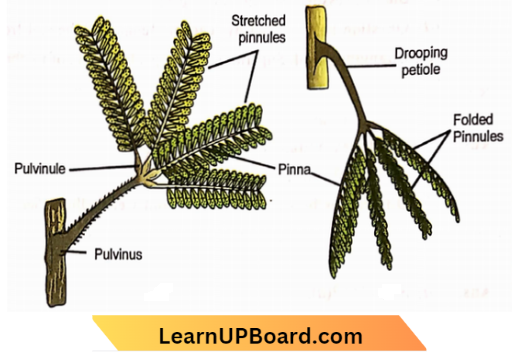
UP Board Class 10 Biology Notes For Coordination In Plants Growth Based Plant Movements
What are growth movements? Name its two types.
They are plant movements caused by differential growth or unequal growth in different parts of the organ. This results in bending and other types of movements. Growth movements are of two types, nastic and tropic.
- Nastic movements are non-directional. They are determined by the structure of the organ and not the direction of the stimulus, for example., the opening of flowers due to greater growth or epinasty on the upper surface of sepals and petals.
- Tropic movements occur in cylindrical organs. The direction of movement is related to the direction of the stimulus. Tropic movements are also called curvature movements.
movement due to growth class 10th
Differences Between Nastic And Tropic Movements
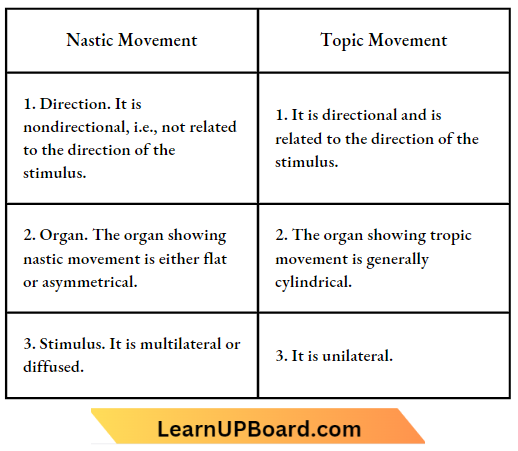
Depending upon the stimulus, tropic movements are of many types—phototropism, geotropism, hydrotropism, chemotropism, and thigmotropism.
1. Phototropism. It is tropic movement in response to uni-directional exposure to light. Stems generally bend towards the source of light.
- They are called positively phototropic. Leaves lie at right angles to the direction of light. They are diaphototropic. Roots are either neutral or negatively phototropic.
- In the stem, the stimulus of light is received by the stem apex. Leaves are essential for it. The region of response is a zone of elongation present below the apex. Blue light is effective in causing phototropism. The photoreceptor is a chemical called phototropin.
- The movement is caused by decreased availability of auxin on the illuminated side and more on the shaded side. The shaded side grows more resulting in bending movement.
- In the root where negative phototropic movement is observed, more auxin on the shaded side causes inhibition of growth (opposite to that of the stem).
Sunflower heads perform suntracking due to positive phototropism while plants growing in the open do not show bending movements as auxin diffuses uniformly in the growing region.
UP Board Class 10 Biology Notes For Coordination In Plants Activity 2.2
Demonstration Of Phototropism
Fix a wire mesh over the mouth of a conical flask full of water. Place one or two freshly germinated bean seeds on the mesh. Take a large cardboard open on one side.
- Place the flask in the cardboard kept near a window so that the seedling receives light from one side only. Observe after 2-3 days.
- The shoot has bent towards the source of light while the root has bent away from it. It shows that the stem is positively phototropic while the root is negatively phototropic.
- Now rotate the flask by 180° and observe after 3-4 days. The shoot and the root have developed curvatures and a new direction of bending by the young shoot towards the light and the young root away from light.
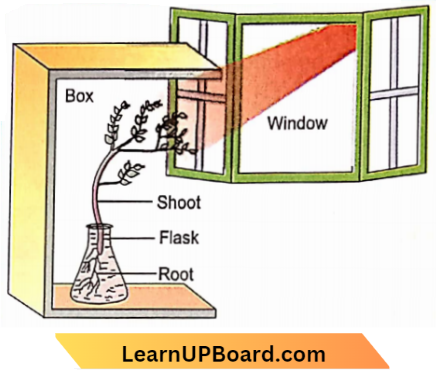
movements in plants
2. Geotropism. It is tropic movement or growth movement of curvature that occurs in response to the vector of gravity. Stems are generally negatively geotropic while roots are positively geotropic.
- Their branches are plagiogeotropic or lie at an angle to the direction of gravity. Stimulus of gravity is perceived by the stem apex, stem nodes, and root cap.
- It is because of the negative geotropic nature of the stem and the presence of receptor regions in the nodes that the lodged shoots become vertical.
- Negative geotropism helps shoots to properly expose themselves to sunlight.
Positive geotropism of roots helps them to fix the plant in the soil and absorb water as well as minerals from the same.
UP Board Class 10 Biology Notes For Coordination In Plants Activity 2.3
Demonstration Of Geotropism
- Place a potted plant horizontally on the ground. Provide support to the pot to prevent rolling. Regularly water the plant. Observe after a week.
- The apical part of the shoot has bent upwardly while the roots have bent downwardly. It shows that the stem is negatively geotropic while the root is positively geotropic.
3. Hydrotropism. It is tropic or directional growth movement of curvature that develops due to unilateral exposure to water. Hydrotropism is mostly seen in roots which are positively hydrotropic. Positive hydrotropic movement of roots is stronger and even overcomes their positive geotropic response.
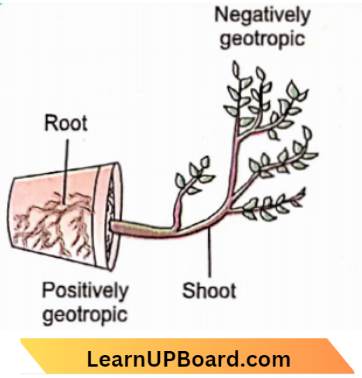
movement of plants
UP Board Class 10 Biology Notes For Coordination In Plants Activity 2.4
Demonstration Of Hydrotropism
Take a sieve. Fill it with moist sawdust and support it on the sides over wooden blocks. Place a few soaked germinating seeds in the sawdust. Sprinkle water over the sawdust.
- Within 1-2 days radicles will be seen coming down from the pores of the sieve and hanging in the air.
- However, within a few hours, the radicle will be found to bend back and enter the wet sawdust showing that the positive hydrotropism of roots is stronger than that of their positive geotropism.

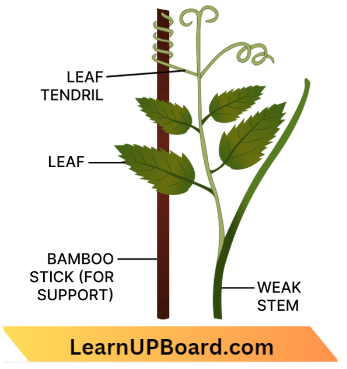
what is thigmotropism class 10
4. Thigmotropism. It is tropic or growth movement of curvature that occurs in tendrils and twiners in response to the stimulus of contact.
- As a tendril or twiner comes in contact with a support, it encircles the same. The reason is less growth in the region of contact and more growth on the free side.
- Here, contact causes less auxin production and hence less growth.
5. Cliemotropism. It is tropic or growth movement of curvature that occurs in plants in response to a chemical stimulus.
- The best example is the passage of the pollen tube through the style and inside the ovary towards the ovule where synergids are sending out chemical signals.
UP Board Class 10 Biology Notes For Coordination In Plants Chemicals Coordination In Plants
What arc phytohormoncs? Why they are called plant growth regulators?
Plants do not have nerves and muscles to coordinate their activities. Instead, they have chemical messengers or hormones.
- Plant hormones or phytohormones are non-nutrient diffusible chemical substances that can control various activities of plants like growth, differentiation, movements, development, and other physiological processes.
- For this, the target or effector cells possess receptors for picking up the hormones. Plant hormones are also called plant growth regulators (PGRs) as they function by promoting or inhibiting growth.
- Major plant hormones are auxins, gibberellins, cytokinins (growth promoters), abscisic acid (growth inhibitor), and ethylene (both promotion and inhibition).
Auxins
They are weakly acidic organic substances having unsaturated ring structures that promote cell enlargement of shoots in the concentration range of 10-100 ppm, which is inhibitory to the growth of roots.
- Natural auxin is indole 3-acetic acid or IAA. Some other examples are IBA, NAA, 2,4-D, 2,4,5-T. 1AA is synthesized inside shoot tips, young developing leaves, and seeds.
Auxins Functions
- Cell Enlargement. Auxin promotes cell growth at a concentration of 10 ppm in the stem and 0.0001 ppm in the root.
- Apical Dominance. Axillary buds do not sprout near the apical bud due to the secretion of auxin by it.
- Prevention of Abscission. Auxin prevents the premature falling of leaves and fruits.
- Movements. Phototropic, geotropic, and other plant movements are caused by differential distribution of auxin.
- Root Formation. Root formation on stem cuttings is stimulated by auxins like NAA and IBA.
- Tissue Culture. Auxin promotes callus formation in tissue culture. Along with cytokinin, it promotes the differentiation of callus into plantlets.
- Fruit Growth. Auxin promotes fruit growth, sweetening of fruit, and even parthenocarpic development of fruit.
- Weedicides. In higher concentrations 2,4-D and 2,4,5-T are used as weedicides.
Gibberellins
They are mildly acidic tetracyclic organic substances that bring about cell elongation of leaves, stems, and fruits in intact plants. They are formed by the young leaves of buds, root tips, and developing seeds.
Gibberellins Functions
- Growth. Gibberellin promotes growth in leaves, stems, internodes, and fruits. They are used to increase the yield of fruits and sugar in sugarcane.
- Overcoming Dormancy. Dormant buds and seeds sprout in the presence of gibberellins.
- Flowering. They can replace cold and long-day requirements for flowering in some plants.
- Parthenocarpy. Like auxin gibberellin can induce the formation of seedless fruits.
- Overcoming Dwarfism. Genetically dwarf plants grow to normal size on the application of gibberellins.
Cytokinins
They are mildly alkaline aminopurine or adenine derivatives that promote cell division in plants, for example., zeatin (natural), and kinetin (synthetic). Cytokinins are synthesized in the root tip and endosperm of developing seeds.
Cytokinins Functions
- Cell Division, Differentiation and Morphogenesis. Cytokinins are essential for cell division, cell differentiation, and morphogenesis.
- Prevention of Senescence. Aging of leaves, marketed vegetables, fruits, and cut flowers can be prevented by the application of cytokinin.
- Accumulation of Nutrients. Cytokinins improve the yield and quality of fruits by stimulating nutrient flow into them.
- Resistance. They enhance the resistance of plants to environmental stresses and diseases.
- Apical Dominance. Application of cytokinins overcomes apical dominance. The nearby axillary buds sprout.
Abscisic Acid (ABA)
It is a mildly acidic organic substance that functions as a general growth inhibitor.
- Abscisic acid can counter the growth-promoting activity of auxins, gibberellins, and cytokinins.
- It helps the plant to overcome stress conditions mostly through induction of dormancy. Therefore, it is known as a stress hormone as well as dormant.
Abscisic Acid Functions
- Controlled Growth. By counteracting the effect of other hormones, abscisic acid or ABA controls growth.
- Wilting. Under conditions of stress, it causes wilting and senescence of leaves.
- Abscission. It promotes the abscission of flowers and fruits.
- Dormancy. Abscisic acid causes dormancy of buds and seeds.
- Transpiration. It checks transpiration by causing the closure of the stomata. Because of this, abscisic acid can also be used as an antitranspirant.
UP Board Class 10 Biology Notes For Coordination In Plants Long Answer Type Questions
Question 1.
- Mention the role of
- Auxin
- Abscisic acid.
- How do plants respond to external stimuli?
Answer:
- Auxin. It promotes cell growth, and apical dominance, and prevents premature leaf and fruit fall while differential distribution causes tropic movements.
- Abscisic Acid. It moderates growth promotion by auxin and gibberellins, prepares the plant for stress tolerance, and induces dormancy of buds and seeds.
- Plant Response to External Stimuli. Plants respond to external stimuli by the two types of movements- turgor movements and growth moments.
Turgor Movements. They are caused by changes in the size and shape of cells through loss and gain of water, for example., opening and closing of stomata, haptonasty in Mimosa pudica, and hydronasty in many grasses.
Growth Movements. They are movements caused by unequal growth. Growth movements can be nondirectional or directional. The non-directional movements are called nastic movements.
- They are not related to the direction of stimulus but to the structure of the responding organ, for example., the opening and closing of flowers.
- The directional movements are called tropic movements. They mostly occur in cylindrical organs. The direction of this growth movement is related to the direction of stimulus, for example., phototropism.
